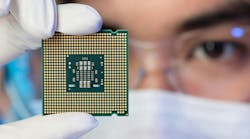Download this article in PDF format.
A 7.4 magnitude earthquake hit Taiwan last week, claiming the lives of at least nine people and threatening one of the world’s busiest semiconductor manufacturing hubs. According to CNN, this was the strongest earthquake to hit Taiwan in the last 25 years. At press time, rescuers were still working to free dozens of people who were trapped as a result of collapsed structures and landslides.
Taiwan Semiconductor Manufacturing Company (TSMC) says that its manufacturing plants experienced “some shaking,” CNN reports, and that it temporarily evacuated some plants following the event. As of Thursday, TSMC said it expected to have fully recovered operations of all of its facilities by the end of the day. According to Business Insider, Taiwan is also home to smaller chip producers, so the island plays an outsized role in supplying semiconductors to companies around the world.
So far, TSMC has reported minimal impacts to its facilities. “A small number of tools were damaged at certain facilities, partially impacting their operations. However, there is no damage to our critical tools,” said TSMC, the world’s largest chipmaker and manufacturer of the majority of the world’s most advanced processor chips.
“While Wednesday’s earthquake appears unlikely to have any long-term implications for the semiconductor supply chain, it gave a stark reminder of the risks of concentrating crucial microchip manufacturing on an island that is both prone to earthquakes and a hotspot for geopolitical tensions,” the publication reports.
A Focus on U.S. Semiconductor Manufacturing
As the earthquake recovery efforts continue, and as chip manufacturers assess the long-term impacts on their operations, the U.S. government is ramping up its financial stake in the domestic semiconductor supply chain. According to the White House, the Department of Commerce just reached a preliminary agreement with Intel to provide up to $8.5 billion in direct funding along with $11 billion in loans under the CHIPS and Science Act.
The announcement will support the construction and expansion of Intel facilities in Arizona, Ohio, New Mexico and Oregon, creating about 30,000 jobs and supporting many more “indirect” jobs. Here’s how this latest CHIPS investment will support Intel’s construction and expansion projects in four different states:
- Chandler, Ariz.: Help construct two leading-edge logic fabs and modernize one existing fab, significantly increasing manufacturing capacity to produce Intel’s most advanced semiconductors in the U.S.
- New Albany, Ohio: Establish a new regional economic cluster for U.S. chipmaking with the construction of two leading-edge logic fabs.
- Rio Rancho, N.M.: Nearly complete modernization and transformation of two fabs into advanced packaging facilities, where chips are assembled together to boost their performance and reduce costs.
- Hillsboro, Ore.: Expand and modernize facilities to increase clean-room capacity and utilize advanced lithography equipment, further strengthening this critical innovation hub of leading-edge development and production in the U.S.
Moving the Needle
According to WSJ, much of the world’s chip production has shifted to Asia in recent decades, leaving the U.S. with around 12% of the world’s chip manufacturing in 2020. “The Chips Act is part of President Biden’s experiment with industrial policy, where taxpayer funds are used to bolster some companies that the administration views as important for national security,” the publication reports. “Biden aides have said that they hope the chip-industry investments, if successful, could serve as a template for how to prod other sectors.”
Under its preliminary agreement with the Department of Commerce, Intel will work closely with workforce training providers (e.g., educational institutions, state and local agencies, labor unions) to develop and train workers for jobs created by the new investment. For example, Intel’s construction spending is contributing to union apprentice programs across all four sites—expected to amount to over $150 million in apprenticeship contributions.








